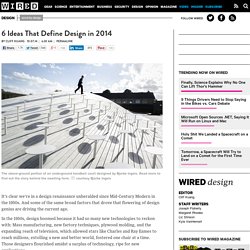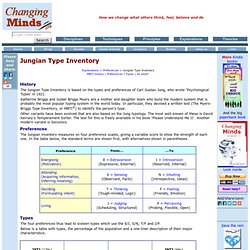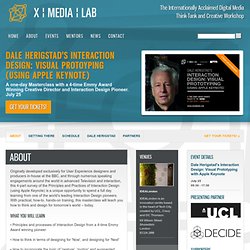

Koupriesleeswijkemp.pdf. 6 Ideas That Define Design in 2014. The above-ground portion of an underground handball court designed by Bjarke Ingels.

Read more to find out the story behind the swelling form. courtesy Bjarke Ingels It’s clear we’re in a design renaissance unheralded since Mid-Century Modern in the 1950s. And some of the same broad factors that drove that flowering of design genius are driving the current age. In the 1950s, design boomed because it had so many new technologies to reckon with: Mass manufacturing, new factory techniques, plywood molding, and the expanding reach of television, which allowed stars like Charles and Ray Eames to reach millions, extolling a new and better world, fostered one chair at a time.
Today, we have cheap silicon, sophisticated sensors, and software that provides limitless avenues of expression. We already have an inkling of what technology will become fodder for designers: Our devices are using more and more data mining and AI to anticipate what we want or need before we even ask for it. 1. 2. 3. 4. 5. Why the Myers-Briggs test is totally meaningless.
MBTI Basics. The purpose of the Myers-Briggs Type Indicator® (MBTI®) personality inventory is to make the theory of psychological types described by C.

G. Jung understandable and useful in people's lives. The essence of the theory is that much seemingly random variation in the behavior is actually quite orderly and consistent, being due to basic differences in the ways individuals prefer to use their perception and judgment. "Perception involves all the ways of becoming aware of things, people, happenings, or ideas. Judgment involves all the ways of coming to conclusions about what has been perceived. Profile of the INFP Personality Type. Jungian Type Inventory. Explanations > Preferences > Jungian Type Inventory MBTI history | Preferences | Types | So what?

History The Jungian Type Inventory is based on the types and preferences of Carl Gustav Jung, who wrote 'Psychological Types' in 1921. Katherine Briggs and Isobel Briggs Myers are a mother and daughter team who build the modern system that is probably the most popular typing system in the world today. In particular, they devised a written test (The Myers-Briggs Type Inventory, or MBTI®) to identify the person's type.
Other variants have been evolved that are also based on the Jung typology. Preferences The Jungian inventory measures on four preference scales, giving a variable score to show the strength of each one. Types The four preferences thus lead to sixteen types which use the E/I, S/N, T/F and J/P. Below is a table with types, the percentage of the population and a one-liner description of their major characteristics. www2.uiah.fi/~ikoskine/idmi05/designinginthedark.pdf. 40 Of The Most Powerful Social Issue Ads That’ll Make You Stop And Think. Many people complain about glossy advertisements and TV commercials as an obnoxious way for companies to invade our everyday lives and ram their products down our throats, but that’s not all that printed ads are good for.
The best commercials on this list are excellent examples of effective advertising strategies for social issues marketing campaigns that let their voices be heard. Leah Heiss Elastic Field. Anxiety 2014. Why The Myers-Briggs Personality Test Is Misleading, Inaccurate, And Unscientific. The Myers-Briggs personality test is entrenched in business culture.

It’s taken by more than 2.5 million people a year. A full 89 of the Fortune 100 companies use it. The test promises to tell you which of the 16 personality “types” yours most resembles, slotted along a range of behavioural binaries. As a refresher, they are: • Extraverted or Introverted• Sensing or Intuiting• Thinking or Feeling• Judging or Perceiving. Interaction Design Masterclass - London.
Originally developed exclusively for User Experience designers and producers in-house at the BBC, and through numerous speaking engagements around the world in advanced Television and interaction, this 4-part survey of the Principles and Practices of Interaction Design (using Apple Keynote) is a unique opportunity to spend a full day learning from one of the world’s leading Interaction Design pioneers.

With practical, how-to, hands-on training, this masterclass will teach you how to think and design for tomorrow’s world – today. What You Will Learn. Life Of Brian (1979) - clip: "You're all individuals" The Science of Beauty. By Maria Popova “Attitudes toward beauty are entwined with our deepest conflicts surrounding flesh and spirit.”

“That is the best part of beauty, which a picture cannot express,” Francis Bacon observed in his essay on the subject. And yet for as far back as humanity can peer into the past, we’ve attempted again and again to capture and define beauty. Collapsible woven refugee shelters powered by the sun. More than 40 million people worldwide have been displaced from their homes and left to find shelter in strange lands.

Maybe they find a tarp, or a tent, but their quality of life almost always remains dismal. To close this gap in need, Jordanian-Canadian architect and designer Abeer Seikaly designed a new kind of shelter. One that allows refugees to rebuild their lives with dignity. RELATED: Gorgeous shape-shifting shelters for nomads and refugees that move with the weather Seikaly, now living in Amman, Jordan is well poised to design a dwelling for refugees given that her ancestors in Jordan probably toggled between nomadic and sheltered life in the desert for centuries.
The FJP. Fluid Surface:Interactive Water Surface Display for Viewing Information in a Bathroom. International Journal of Design.
Week 12. Week 11. Week 10. Week 9. Design Museum’s Shortlist for Designs of the Year 2013. Journal of Consumer Research, Vol. 39, No. 1 (June 2012), pp. 22-38. May + June 2013. Week 8. Week 6. Week 5. Week 4. Week 3. The Psychological Basis for UI Design Rules. Week 2. BBC Three - Secrets of the Superbrands (Technology)